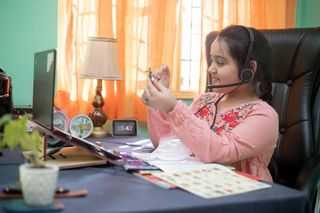Emergency remote learning should not be confused with planned and intentional virtual learning.
That was one of the key themes of a recent webinar hosted by Dr. Kecia Ray and sponsored by Stride Learning Solutions, which provides online and blended education programs.
During the discussion, Bouchra Bouanani, executive director of Miami Virtual Program Arizona, an online K-11 public school in Arizona, and Cindy Wright, vice president of academics at Stride, discussed the benefits of virtual learning and cleared up misconceptions about online learning.
View the on-demand version here.
Key Takeaways
Myth: Remote learning and virtual learning are the same
“Remote learning is trying to adapt a brick-and-mortar program and run it remotely,” Bouanani explained. “In virtual learning, the whole student and teacher experience is tailored to learning from home, so the platform, the interactive curriculum, teachers’ expectations for live instruction, everything is made for a virtual learning experience.”
Wright added that a robust virtual learning environment should be designed to work with diverse learners and provide a continuum of support for students. This type of virtual school and curriculum can enhance fully online, blended, or even in-person learning.
Myth: Students lose socialization when participating in a virtual learning environment
In the past, socialization in online classes was difficult but that has changed, and students in virtual schools will meet in person and gather for social events online. “The amount of socialization available in a virtual environment is a shock to most people,” Wright said. “We have some things that can be purely social – they're going to meet at a local zoo, or they're going to meet in a Zoom room and they're going to see a guest speaker who's talking about how to get into gaming.”
Virtual schools also enable students to form friendships that are not limited by geography. “You have some students, especially in small towns, they might have a particular area that they're so interested in, but not a lot of other kids in the neighborhood or in the local area have that interest,” Wright said. “So you're able to have that worldwide connection and that national connection.”
Bouanani said that as an online educator and as a parent whose children attend virtual school, she’s seen powerful social interactions firsthand. Her children have attended dances, taken internships, joined clubs, and made lifelong friends.
Myth: Virtual learning is generally asynchronous
“Online learning offers synchronous live sessions daily as well as open office hours, where students can come and get extra supports based on student data,” Bouanani said. In her school, there also are synchronous enrichment sessions for advanced and gifted students, and special education services with special education teachers, as well as synchronous services for English learners.
Wright said that at Stride, they spend a lot of time working with teachers and staff on creating effective synchronous interactions with students. “It's even part of their observations, their evaluations, that they're engaging students on a regular basis [synchronously],” she said.
Myth: Online students have very limited interaction with their teachers
“Students have just as much if not more access to quality time with their teachers in a virtual environment,” Wright said. Virtual learning also allows students to be organized into different groups more efficiently. “You're able to group students by abilities or project or what have you.”
To be effective, synchronous virtual learning often requires interaction between the teacher and students and between each student and their classmates. “If anything, students interact more with their online instructors and students in a live session,” Bouanani said. “Students are always eager to participate during live sessions. Teachers go the extra mile and get super creative to include everybody in that conversation. So student opinion and voice feel valued in the online environment.”
Myth: Field trips don’t occur in virtual learning
Students who attend Miami Virtual Program Arizona participate in virtual and physical field trips. For physical field trips, the school will often offer several meet-up locations to accommodate families who live in different parts of Arizona. “If it's a park day, we'll have 10 locations depending on where the students are,” Bouanani said. “If it's a museum, it will be museums around the state.”
Virtual schools are also set up for students to easily participate in virtual field trips. “One thing I like about virtual field trips, we are not bound by time,” Wright said. “We can do a virtual field trip at Shakespeare's Globe Theater, and take children where passports would be required. So they become less limited, and they're not so locally dependent on what's available in the area.”

